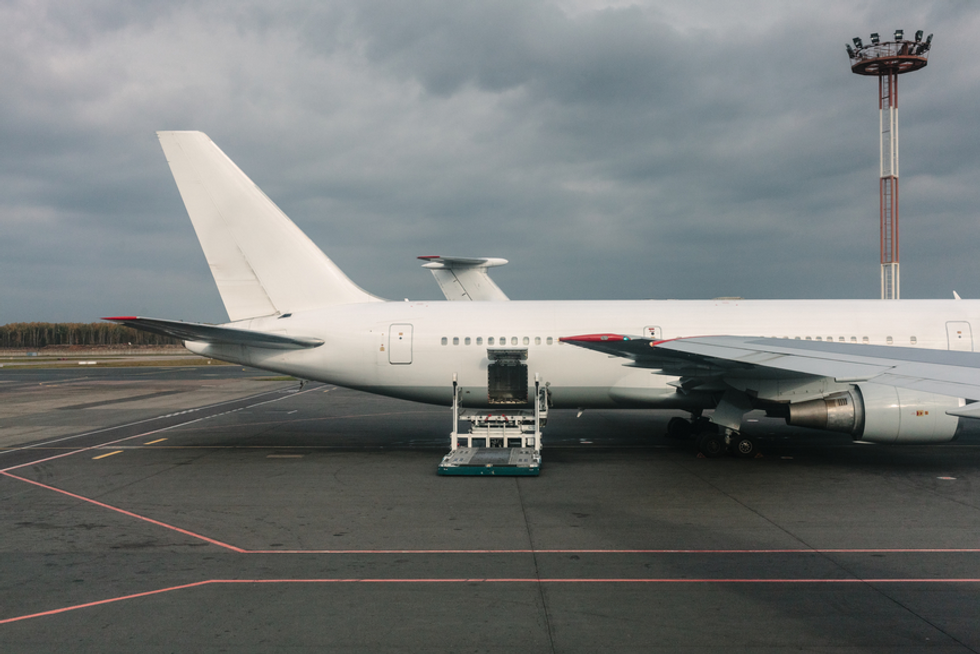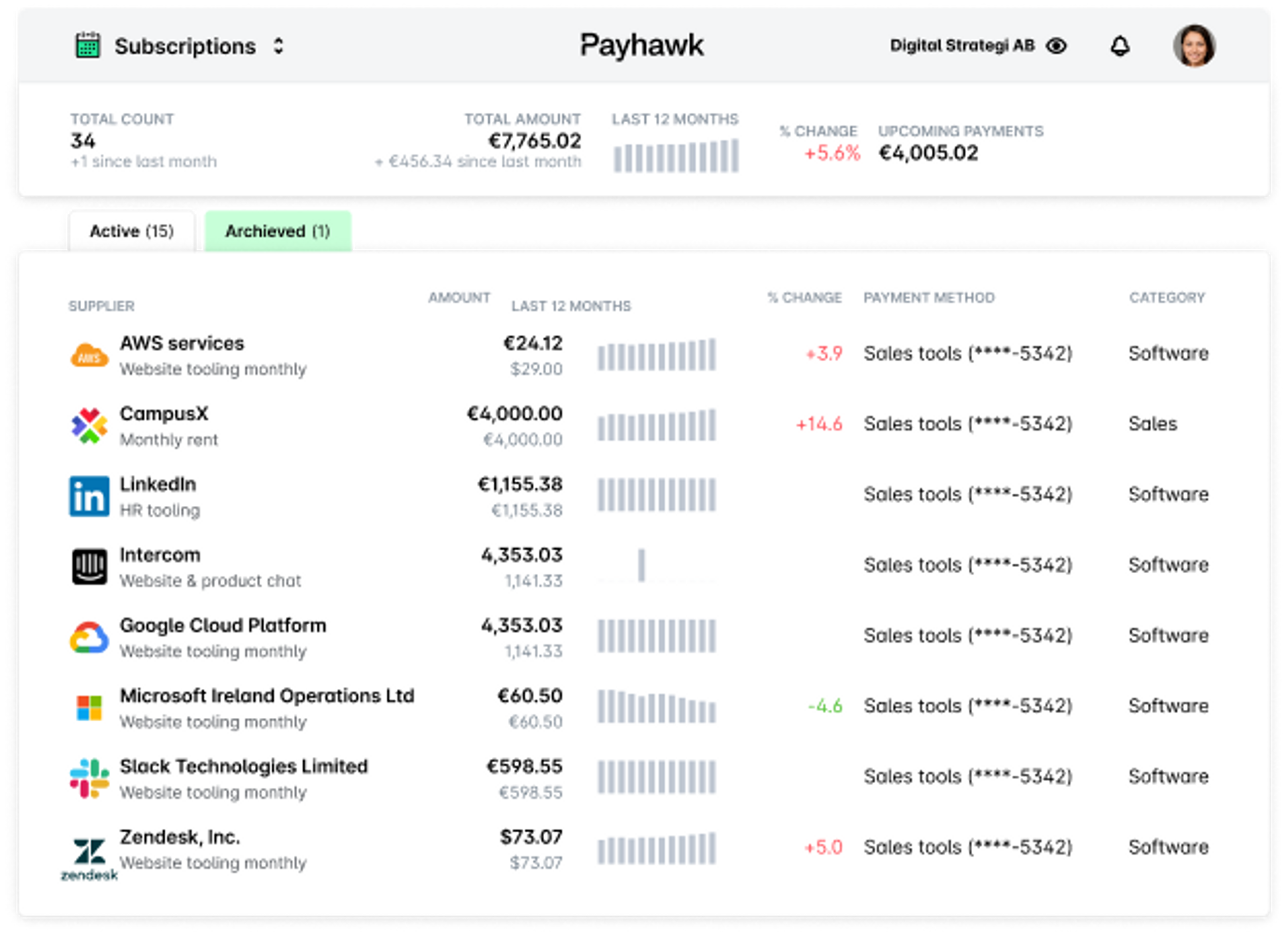
Aviation expenses: How to take control of aviation industry spend



The aviation industry is not cheap. There are many different costs involved in keeping planes in the air and bums in their seats. And now more than ever, the industry needs to turn to intelligent expense management technology to ensure it can manage its operations efficiently, cost-effectively, and without error.
By submitting this form, you agree to receive emails about our products and services per our Privacy Policy.
The aviation industry has a lot of unique challenges when it comes to managing expenses and keeping the wheels of business turning. It has significant costs and needs the right mix of corporate cards and expense management software to help it stay the course.
What are the major operating expenses of airlines?
Why is general aviation so expensive? And what is the split in costs? Some of the biggest expenses include:
- Fuel costs: The price of aviation fuel is a significant expense for airlines, and fuel can account for up to 30% of an airline's cost structure
- Labour costs: The aviation industry is labour-intensive, requiring many employees to operate a single flight. Labour costs, including salaries, benefits, and pensions, can be a significant expense for airlines
- Aircraft maintenance: Airlines must maintain their aircraft to ensure they operate safely and efficiently. The maintenance cost can be high, especially for older planes or those with more complex systems
- Aircraft leasing or purchasing: Airlines must either lease or purchase their aircraft. Leasing can be a significant expense, as airlines must pay monthly fees for using the aircraft. Purchasing aircraft outright can also be a significant expense, as planes can cost hundreds of millions of pounds or dollars
- Airport fees: Airlines must pay fees to airports for using their facilities, including runways, gates, and terminals. These fees can be a significant expense, especially for airlines that operate at multiple airports
- Insurance costs: Airlines must carry significant insurance coverage to protect against accidents and other incidents. The insurance cost can be high, especially for airlines with large fleets
Overall, aviation expenses are complex and eye-watering, meaning finance teams must manage costs carefully to support profitability, stability – and even safety.
How to manage airline fuel expenses and rebilling
Why is managing expenses so challenging for the aviation industry?
While most industries have their fair share of expenses, the aviation industry soars above many of these thanks to the super high cost of things like fuel. In recent years, fuel prices have fluctuated dramatically, making cash flow management stressful and unpredictable for finance teams.
No one on the inside is asking, is aviation fuel expensive? It's a given. But far from being the only challenge, fuel prices are just part of the mix that can make managing business payments a headache at aviation companies. Other challenges include:
High fixed costs: The aviation industry has high fixed costs, such as aircraft purchase or leasing, salaries for pilots, engineers, and ground crew, airport fees, and maintenance costs. And the industry incurs these costs regardless of the number of passengers on a flight or flights, making it challenging to adjust expenses to match revenues.
Volatility of fuel prices: Fuel prices are one of the most significant airline expenses, and they can be volatile and subject to sudden increases or decreases. These dramatic fluctuations can make it challenging for airlines to predict costs and adjust their operations accordingly.
Complex regulatory environment: The aviation industry is subject to numerous regulations, such as safety requirements, security measures, and environmental standards, which can increase expenses.
Competition: The aviation industry is highly competitive, and airlines must continually innovate to remain competitive. Striving for innovation can also lead to additional expenses, such as investing in new technology, upgrading the fleet, or offering unique amenities to passengers.
Unpredictable events: Global and local events can significantly dent the aviation industry's performance. With Covid-19 fresh in our minds, it's worth mentioning that events like pandemics, natural disasters, and political unrest can massively impact the aviation industry. These events can cause a decline in passenger demand, increased operating costs, and lost revenue, making it challenging for airlines to manage their cash flow and expenses accordingly.
So, how can airlines and aviation companies best prepare for these challenges? And have they already switched on to expense management?
How has the aviation industry traditionally borrowed and spent money?
Bank lending traditionally plays a big role in supporting the aviation industry and the way it works for the following reasons:
- Aircraft purchases: The aviation industry relies on loans from banks to finance the purchase of aircraft. Commercial aircraft are highly expensive assets, and airlines often need significant funding to acquire or lease them. Bank lending has traditionally provided the necessary capital to make these substantial investments
- Fleet expansion and modernisation: Airlines may need to expand their fleet or upgrade existing aircraft to meet growing demand, enhance operational efficiency, or comply with environmental regulations. Bank loans have typically enabled them to access the funds required for fleet expansion and modernisation initiatives
- Working capital and cash flow management: Airlines have ongoing operational expenses, such as fuel costs, crew salaries, and maintenance expenditures. Bank lending has traditionally helped airlines manage their working capital and maintain sufficient cash flow to cover day-to-day expenses
- Infrastructure development: Airports require substantial investments in infrastructure development, including runway expansions, terminal upgrades, and technology enhancements. Often, banks provide loans to airport authorities, allowing them to undertake these infrastructure projects and accommodate the industry's growth
- Research and development: The aviation industry continually invests in research and development (R&D) to innovate and improve aircraft design, safety features, fuel efficiency, and passenger comfort. Traditionally, banks have provided loans to aviation companies to support their R&D efforts and promote technological advancements
- Economic impact: The aviation industry contributes significantly to the economy by generating employment, facilitating tourism and trade, and supporting related sectors such as hospitality, logistics, and manufacturing. Bank lending has typically ensured the industry's stability and growth, thereby preserving its positive economic impact
However, it's important to note that bank lending carries risks, and financial institutions assess the creditworthiness of borrowers before extending loans. Economic factors, industry performance, and the financial health of individual airlines also impact the availability and terms of bank lending to the aviation sector.
What's more, it can be easy for companies to quickly hit their card limits with banks and then incur business-damaging delays. At the same time, they wait to solve the issue by either requesting increases to their credit limits, reaching for personal credit cards, delaying supplier payments, or seeking short-term (high-interest) financing — all options which carry risk and potential delay.


The importance of high-limit global corporate cards
The aviation industry is global, which means that it spreads across multiple countries and currencies. Airlines and aviation companies must manage their expenses and finances across borders to operate efficiently and effectively. That's where corporate cards come in.
Corporate cards are credit or debit cards issued by a financial institution to a company or organisation to cover business expenses. Employees can use these cards to make purchases or payments on behalf of the company.
Getting global reach with global cards
Many industries have global reach, but for the airline industry, it's literal. Let's take Paula, the pilot, for example. She started her day in London and ended it in New York, and now she's expensing her well-earned meal and hotel stay.
Paula needs a corporate card that has a high acceptance rate and can work in the UK and the US. And she needs it to be simple so she can pay as she needs, upload evidence in seconds, and get back in the air tomorrow. She hasn't got time to staple receipts, hunt down policies, and fill in forms.
Back on the ground, her company's finance team has better things to do than chase receipts. And with the right spend management solution, there's no need. They can check Paula's spend (and any business spend) in real-time. Any missing receipts are automatically chased, and all the spend data is transferred automatically to their chosen ERP via direct integration, with no need for manual reconciliation.
By using corporate cards (and expense management software — ideally all-in-one) in multiple countries, the aviation industry can streamline its expense management and financial reporting processes. Corporate cards can provide a centralised platform for tracking expenses and monitoring spending across different countries, currencies, and vendors. This can help companies to optimise their spend and identify cost-saving opportunities.
Additionally, corporate cards can offer benefits such as cashback, and fraud protection, which can further improve the financial performance of aviation companies.
Using corporate cards in multiple countries can help the aviation industry effectively manage its expenses and finances, streamline its operations, and improve its financial performance.
Taking off with high-limit cards
Aviation expenses are jumbo-sized. From supplier payments and fuel to maintenance, the industry regularly needs to spend big on the following areas, and here's where high-limit credit cards can help keep things moving.
Operational expenses: including fuel costs, aircraft maintenance, airport fees, and crew salaries. High-limit credit cards allow them to cover these expenses and maintain smooth operations
Aircraft purchases and leasing: Airlines often need to purchase or lease new aircraft, which involves substantial upfront costs. High-limit credit cards can be used for down payments, security deposits, or even full payments in some cases
Travel and accommodation: Airlines frequently need to book travel and accommodation for their crew members, especially during layovers or when attending training programs or industry conferences. High-limit credit cards enable them to make these reservations and cover associated costs
Supplier payments: Airlines have various suppliers, such as aircraft manufacturers, spare parts providers, catering services, and IT support companies. High-limit credit cards allow them to make prompt payments to suppliers and maintain good relationships
Emergencies: The aviation industry is subject to unforeseen circumstances like maintenance emergencies or natural disasters that can incur high costs. High-limit credit cards provide a financial safety net to address such emergencies promptly
Of course, it's worth noting that while high-limit credit cards offer greater purchasing power and flexibility, finance teams must use them responsibly to avoid debts and fees.
With a corporate spend management solution like Payhawk, business aviation can take advantage of our following key card benefits:
- Credit limits of up to £/$250K based on assessment
- Multi-currency credit lines in GBP and EUR
- Interest-free card purchases (additional fees apply for late credit repayments)
- Zero personal credit checks and no personal guarantees required
- Use Apple and Google Pay
- FX savings compared to traditional banks cards
- Virtual and physical company cards
- In-built card controls like auto-blocking ATM withdrawals, and approval workflows
- And connected, dedicated expense management software and ERP integrations
Taking control with corporate cards
Like any other sector, the aviation industry requires proper controls for corporate credit cards to ensure that they are used responsibly and accountable. Some of the corporate card controls that are particularly relevant to the aviation industry include:
Spending limits: Companies in the aviation industry may need to impose limits on their corporate credit cards based on job roles and responsibilities. For example, a pilot may have a higher spending limit than a flight attendant, who may have a higher limit than a ground staff member.
Transaction categories: Companies may need to restrict the types of transactions that can be made on their corporate credit cards. For example, a company may allow airfare and hotel bookings but not meals or entertainment expenses.
Merchant categories: Similar to transaction categories, companies may restrict the types of merchants where their employees can use their corporate credit cards. For example, a company may allow purchases only from airlines or hotel chains that they have contracts with.
Approval processes: Companies may require a manager or supervisor to approve certain expenses before they can be charged to a corporate credit card. These approvals help ensure that all expenses are necessary and reasonable.
Receipts and documentation: Companies in the aviation industry may require teammates to provide receipts and documentation for every expense charged to a corporate credit card. This documentation helps to ensure that the finance team can properly document and track expenses for accounting and reporting purposes.
Cardholder responsibility: Companies may need to educate their employees on their responsibilities when using a corporate credit card. This may include ensuring that expenses are necessary and reasonable, following company policies and procedures, and reporting any lost or stolen cards immediately.
Aviation expenses require proper corporate card controls to manage costs effectively and responsibly. These controls may include spending limits, transaction and merchant categories, approval processes, receipts, documentation, etc.
Currencies and controls: Getting global cards right
The aviation industry is a global sector that involves travel across borders and often requires payment in different currencies. As a result, corporate cards with global currencies are essential for the companies involved.
Companies can avoid the hassle and expense of converting currencies and paying currency exchange fees by using a corporate card with global currencies. These types of corporate cards allow companies to make payments and transactions in multiple currencies, which is essential for managing expenses related to international travel, such as airline tickets, hotel stays, and meals.
Additionally, corporate cards with global currencies often come with features that make them ideal for business travel, such as free FX fees and expense controls. These features can help companies manage travel expenses more efficiently and save money in the long run.
Overall, corporate cards with global currencies are crucial for the aviation industry as they enable companies to conduct business across borders and manage their travel expenses more effectively.
Why does the aviation industry need corporate cards with fast issuance?
The aviation industry is a fast-paced business that often requires quick decision-making and immediate access to funds. Therefore, corporate cards with fast issuance are essential for companies in this industry.
Fast issuance corporate cards allow companies to quickly issue cards to their employees, giving them immediate access to funds for business expenses. This is important in the aviation industry, where employees may need to travel on short notice and require access to funds for expenses like airline tickets, hotel stays, and meals.
Additionally, fast corporate card issuance allows companies to respond quickly to changing business needs, such as unexpected travel requirements or new business opportunities. They can issue cards to new employees or temporary staff members who may only be working temporarily.
Furthermore, fast issuance corporate cards offer convenience and flexibility, allowing employees to make purchases and payments without waiting for lengthy approval processes or reimbursement procedures. This can help streamline expense management and save time and money for both the company and its employees.
Overall, the aviation industry needs corporate cards with fast issuance to keep up with the fast-paced nature of the business and provide employees with quick access to funds for business expenses. At Payhawk, we provide both physical and virtual Visa corporate cards, with virtual cards available for use in just seconds.


Tracking card spend: Subscription management
The aviation industry currently gets onboard with various types of subscriptions, including:
- Flight information services: These subscriptions provide real-time information on flight schedules, delays, cancellations, and other critical information that helps airlines and other aviation industry players to plan and manage their operations effectively
- Airline booking systems: Airlines subscribe to booking systems that allow them to manage their reservations and ticket sales. These systems can integrate with other systems, such as airport check-in and boarding systems, to provide a seamless experience for passengers
- Aviation training services: Airlines and other aviation industry players subscribe to training services to ensure that their employees, including pilots, flight attendants, and ground staff, are properly trained and updated with the latest safety and operational procedures
- Aircraft maintenance and support services: Aviation companies subscribe to maintenance and support services to ensure their aircraft are maintained and serviced according to industry standards. These services include regular maintenance, repairs, and technical support
- Aviation weather services: Aviation industry players subscribe to weather services that provide up-to-date information on weather conditions that can affect flight operations, such as thunderstorms, icing, turbulence, and other weather-related hazards
- Aviation market intelligence services: These subscriptions provide data and insights on market trends, competitor analysis, and other market intelligence that helps aviation industry players make informed decisions about their business strategies
Phew. Clearly, the amount of subscriptions and correctly managing them all is a big undertaking for aviation companies.
At Payhawk, our comprehensive subscription management features enable aviation companies automatically track recurring payments to ensure they don’t overpay or miss payments. In brief, our subscription feature includes the following big benefits:
- Uncover hidden costs and duplicate subscriptions
- Eliminate cost creep
- Predict subscription bills so you can make sure you have available funds
- Auto top-ups
Does the aviation industry use expense management software?
The short answer is yes. Many aviation industry members have already started using expense management software to streamline and automate their spend management processes.
With the increasing complexity of travel expenses and the need to manage costs efficiently, airlines and aviation companies have been turning to software solutions to help control costs, improve accuracy, and reduce the burden on administrative staff for some time.
The problem? Many of these same companies are now stuck with disconnected legacy solutions that aren't yet making expense management, spend control, and payments as easy and efficient as possible.
Many companies use expense management software to automate expense reporting processes, including submitting and reimbursing expenses. But they aren't using tools that include almost instant reimbursements, policy compliance and adoption, receipt capture and chasing, and even well-connected high-limit credit cards.
Sometimes at Payhawk, we talk about this as 'the second wave of digital transformation,' meaning corporate cards, invoice management, subscriptions, card policies, travel and expense controls, ERP integrations, and more, all in one place — no more switching between solutions and clunky data imports.
Overall, there's still a massive opportunity for many of the players within the aviation industry to jump on board the second wave of digital transformation to better manage costs, increase efficiency, improve accuracy in their expense management processes, and avoid missing receipts and lost VAT reclaims.
How do lost expense receipts impact the aviation industry?
Lost expense receipts can significantly impact the aviation industry, creating several challenges for expense management and financial reporting.
Compliance: In the aviation industry, companies must comply with strict financial regulations and reporting requirements. Lost receipts can make providing adequate documentation and evidence for audits and compliance reviews difficult
Financial accuracy: Lost expense receipts can lead to financial reporting, budgeting, and forecasting inaccuracies. Without a proper record of expenses, companies may overstate or understate their actual expenses, leading to inaccurate financial reports and budgeting decisions.
Loss of VAT reclaims: In some cases, lost receipts can result in missed tax deductions for business expenses. This can result in higher tax bills for the company and reduce its overall profitability
Lack of visibility: Lost receipts can make it difficult for aviation companies to gain visibility into their overall expenses, hindering their ability to identify cost-saving opportunities and optimise their spending
Reimbursement delays: If your business doesn't use corporate cards and opts for reimbursements instead, then lost receipts mean delays in processing and payment, creating frustration and dissatisfaction among employees
Overall, lost expense receipts can create several challenges for the aviation industry. Aviation companies must implement strong expense management policies and procedures to mitigate these challenges, including measures to ensure proper documentation and storage of receipts.
The best way to document and store receipts? Fast, easily, digitally, and with no need to save piles of paper. And even better, with more spend categorisation in-built, the finance team doesn't have to reconcile spend against budget and unpick data later.
How digital receipt capture can help
Digital expense receipt capture can help solve the problem of lost receipts for businesses and their finance teams. No more lost receipts mean no more missing info and potential VAT losses.
Some of the other benefits include:
- Compliance
- Savings (tracking expenses to pinpoint savings opportunities)
- Time-saving (for cardholders and the finance team. No data entry and errors!)
- Spend visibility
- Data transfer via integrations (meaning all spend data goes straight from payment to reconciliation, without manual checks)
Overall, digital expense receipt capture is critical to managing expenses in the aviation industry, providing compliance, cost savings, efficiency, transparency, and integration benefits.

Why does the aviation industry need custom API integrations to ERP and accounting software?
The aviation industry often relies on complex and interconnected systems to manage its operations. In order to effectively manage various aspects of their business, including inventory, maintenance, and scheduling, aviation companies typically use enterprise resource planning (ERP) and accounting software.
Custom API integrations between these systems and other software platforms can benefit aviation companies significantly, including streamlining processes, improving accuracy and visibility, and informing decision-making.
At Payhawk, our direct integrations align with the principle of accrual accounting by distinguishing between the dates of invoice/receipt generation and payment recognition. This distinction enhances accuracy and reduces the workload at the other end, meaning fast error-free reconciliation.
Getting expense policies right and encouraging compliance
Like many other industries, the aviation industry has expense policies in place to ensure that employees are spending company funds responsibly and ethically. These policies help control costs, prevent fraud and abuse, and ensure expenses are properly documented and accounted for.
Aviation industry employees must comply with these expense policies for several reasons. First, non-compliance with expense policies can result in financial losses for the company. For example, suppose an employee submits an expense report that includes inappropriate or excessive expenses. In that case, the company may have to bear the cost of these expenses, which can add up over time.
Second, non-compliance with expense policies can lead to reputational damage for the company. Suppose an employee is found to be engaging in unethical or fraudulent behaviour related to expenses. In that case, it can harm the company's reputation and erode customers, shareholders, and stakeholders trust.
Finally, compliance with expense policies is a legal requirement in many jurisdictions. For example, companies in the United States must comply with the Sarbanes-Oxley Act, which requires establishing and maintaining adequate internal controls over financial reporting, including expense-related controls.
Here are some of the measures aviation companies typically take to introduce policy and encourage compliance:
- Create and communicate policies in an easy-to-use way (ideally, companies will use cards and expense management software with policies built-in. At Payhawk, for example, we create customisable policies right into the app. Meaning finance teams can set spending limits and approval workflows in the same place their teammates spend)
- Training programs and company values about cost-saving and cost-conscious decision making
- Approval processes for expenses, corporate card fund requests, and more
- Expense tracking and reporting
- Audit/compliance reviews
By implementing these measures — especially number one — aviation companies can help ensure their employees comply with expense policies and guidelines, reduce costs, and allocate resources effectively.
The problem with missing spend visibility for low-margin aviation businesses and why they must track spend
A lack of spend visibility is bad for low-margin aviation businesses for several reasons, including:
Inability to control costs: When an aviation business doesn’t have visibility into its spending, it becomes difficult to control costs. This can lead to overspending on particular areas or activities, further reducing already-low margins.
Inaccurate financial reporting: A lack of visibility into spending can lead to incorrect financial reporting, making it difficult for aviation businesses to secure funding or make informed decisions. This can further impact profitability and the ability to grow the business.
Difficulty in identifying cost-saving opportunities: It becomes challenging to pinpoint areas for saving without good visibility. Low-margin aviation businesses must identify and take advantage of these opportunities to increase profitability.
Overall, a lack of spend visibility can be detrimental to low-margin aviation businesses, leading to increased costs, reduced efficiency, inaccurate financial reporting, and a missed opportunity to identify cost-saving opportunities.
Aviation companies must therefore track project spend to understand what they are spending, how to manage their resources, what cost control measures to spend, how to accurately bill customers, and ensure they meet all necessary regulations.
See how Luxair became a cashless business
Why aviation companies need easy expense reimbursements
The aviation industry involves a lot of domestic and international travel, which often leads to employees incurring various expenses such as meals, transportation, lodging, and other incidentals. These expenses can quickly add up, and companies need to have an efficient expense reimbursement process to ensure that they can reimburse employees in a timely and accurate manner.
An easy expense reimbursement process benefits aviation industry employees for several reasons. Firstly, it can reduce the financial burden on employees who must pay out-of-pocket expenses. It can also improve employee satisfaction, as timely and accurate reimbursements can make them feel valued and appreciated by their employer.
Secondly, easy expense reimbursements can improve productivity by reducing employees' time and effort to track and report their expenses. If the reimbursement process is simple and straightforward, employees can focus more on their work and less on administrative tasks.
Finally, an efficient expense reimbursement process can help companies to maintain accurate records and comply with legal and tax requirements. This can also help prevent fraud and errors, saving the company time and money in the long run.
In summary, easy expense reimbursement processes are crucial for aviation industry employees because they can reduce the financial burden on employees, improve employee satisfaction and productivity, and help companies maintain accurate records and comply with legal and tax requirements.
Why modern aviation companies need to turn to SaaS
SaaS solutions are particularly attractive to the aviation industry because they offer several benefits, including:
- Cost savings: SaaS solutions are typically subscription-based, which means that companies only pay for the services they use without the need for expensive infrastructure, hardware, or IT support
- Scalability: SaaS solutions are designed to be scalable, so companies can easily add or remove users or services as their business needs change
- Flexibility: SaaS solutions are accessed over the internet, which means that users can access them from anywhere with an internet connection, making them particularly useful for companies with multiple locations or remote workers
- Security: SaaS providers typically have robust security measures in place to protect their customers' data, which can be particularly important for the aviation industry, where security is a top priority
In particular, aviation companies need to lean on SaaS that is super relevant to their operations, including:
Flight operations management: SaaS solutions help airlines manage their flight operations, including scheduling, crew management, and dispatch.
Airport management: SaaS solutions help airports manage their operations, including terminal operations, passenger flow, and baggage handling.
Customer relationship management: SaaS solutions help airlines manage customer relationships, including ticketing, reservations, and loyalty programs.
Aviation safety management: SaaS solutions help companies manage their safety programs, including risk management, incident reporting, and compliance.
So, yes, the aviation industry does use SaaS solutions, which offer cost savings, scalability, flexibility, and security benefits. But are there any they're missing? How about expense management?
Smooth landings with spend management SaaS
At Payhawk, we’re a leading solution for managing expenditures, catering to both domestic and international businesses across Europe, the US, and the UK. By combining features such as company cards, reimbursable expenses, accounts payable, and seamless integration with accounting software, we offer a comprehensive product that simplifies business payments for all users.
At Payhawk, we’ve successfully assisted customers in over 32 countries, empowering them to optimise efficiency, manage spending at scale, and maintain agility. With a presence in various cities, including London, Berlin, Barcelona, Paris, Amsterdam, Vilnius, Sofia, and New York, we serve a diverse clientele, including renowned companies like LuxAir, Babbel, Vinted, Wallbox, and Wagestream.
Book a demo to learn how Payhawk could help your aviation business take flight. Let’s talk.
Trish Toovey works across the UK and US markets to craft content at Payhawk. Covering anything from ad copy to video scripting, Trish leans on a super varied background in copy and content creation for the finance, fashion, and travel industries.
Related Articles


Sage Intacct integrations with spend management: Worth it?

